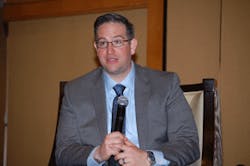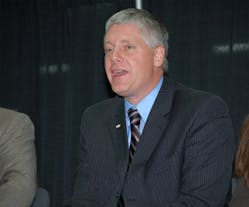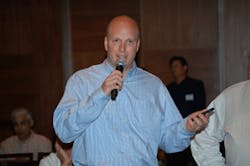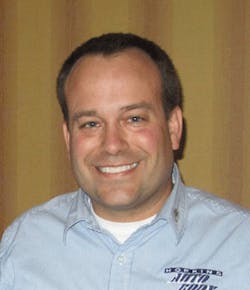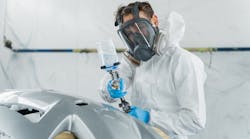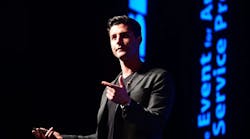What do you get when you bring together some shop owners and shop association executives to talk about what’s happening in the industry now and what might happen in the future? Interesting ideas and discussion.
For the sixth year in a row, ABRN convened a panel (see sidebar, “Who Was At The Table?”) to discuss some of the key issues facing collision repairers – and offer some predictions on what may lie ahead.
Here are some of the highlights of this year’s “roundtable” discussion. (Some responses were edited for length or clarity.)
Dan Risley is the executive director of the Automotive Service Association (ASA).
ABRN: Let’s say you had a chance to sit down for an hour with the national claims manager at a Top 10 insurance company. What is one thing you’d suggest they could do to help shops be more efficient and thus reduce the insurer’s costs or improve the customer’s experience?
Dan Stander: I would say: Is there something we can do to help the people on the insurance estimating side, the adjusters, write a better quality estimate? I think there’s opportunities there with training to make sure we’re getting more of the parts on the estimate, to make sure we’re getting proper labor on the estimate. Not only to help cycle time but also customer satisfaction. When we start out with a $1,000 or $2,000 estimate and it grows to $3,000, $4,000 or $5,000, we just know that creates huge delays.
Mark: Dan, that was pretty close to my No. 1 response, too. Support that idea of doing complete discovery and parts verification at the very front end of the repair. We call it answering every single question at the beginning of the process so we can reduce the number of supplements. When that $1,000 estimate balloons into $5,000, that creates delays and tremendous customer dissatisfaction because suddenly their expectations about the severity of the claim and how long repairs are going to take have just shot though the roof. Some of that dissatisfaction is directed both at the insurer and the shop. The blueprinting process creates fantastic customer satisfaction, and saves money for the insurer by reducing the number of transactions or supplements as well.
Aaron: I think there’s a pervasive belief [among insurers] that market practice should influence repair procedure. Our members see it all the time. The argument can be ‘Well, that’s not market practice to charge for that,’ even if it is a documented OEM procedure. I think one of the best things that any insurer could do would be stop arguing documented OEM required procedures, and simply focus on discussing the areas that are more subjective. That would make the process go a lot better and also would encourage much better quality repairs. The consumer would ultimately win.
ABRN: Dan Risley, you have some previous experience working for a major insurer. What would you talk to a national claims manager about now?
Dan Risley: I would ask them to eliminate requiring having to use a specific part, or having a KPI (key performance indicator) around parts usage. I think if you just allow the shop to choose the right part for the job, it would improve shop’s efficiency and also help drive down the costs that are passed on to insureds through premiums.
ABRN: Which aspect of vehicle technology do you see most impacting repair processes moving forward, and how can shops prepare?
Mark: Where I see the real challenge is the use of multiple advanced materials on the same vehicle. Like an aluminum and ultra-high-strength steel uni-side welded with an invisible weld. You’re going to be need to know where those two materials are joined, but it’s going to be invisible until you remove the top coat. Or there may be a carbon fiber side structure with an aluminum skin on top next to an ultra-high-strength steel piece. So instead of having an aluminum clean room, you’re going to have to have a ‘clean shop’ because you’re going to have multiple materials on the same vehicle. That’s going to be a challenge.
Aaron: Mark is right in that we’re going to see a ton more joining of mixed materials. I think ‘joining’ is going to be one of the biggest design and technology changes. You now have vehicles with laser welding and friction-stir welding and mechanical fastening. Different OEMs have different requirements, if they’re using rivets, for example, for how to remove those rivets, where to reapply those rivets, which types of rivets to use. Following those procedures is going to be critical to the structural integrity of the vehicle, and some of the OEMs are changing their approach from one model to the next.
Dan Risley: I think the technology piece will probably have a even greater impact on collision repairers than the new materials. Those new materials require information and tooling, but once you have that stuff, you should be able to properly repair the car. The unknowns right now are things relative to technology and telematics. All the accident avoidance systems, for example, need to be calibrated after an accident. Who is going to do that? These vehicles are going to be communicating with satellites, with road signs and streetlights, with the cars in front and behind. Who has the information to fix that? Do I need to send that car out somewhere for that? Even the infotainment systems pose questions. As drivers input all their phone numbers, addresses and music into their car, who has access to all that after an accident and how do you get it back into the vehicle? That to me will have a far greater impact than other things because there are a lot of unknowns surrounding it.
ABRN: For the shop owners, what is one thing you are doing differently within your business today than you were a year ago?
Mark: We have changed the way we manage production. In some ways, technologically it’s a step backward. Inside the shop we have what we call a visual production board. We use magnets to represent the vehicles, with information about each vehicle that’s color coded. We used to have one or two managers who were responsible for making production decisions. Our goal with this board is transfer all of the information to all of the technicians to allow them to start making decisions about what they should be working on now and what they should be working on next. It no longer requires a technician to find a production manager. That manager can focus on different issues.
Gerald: We’ve moved to a team body tech system. We started out with a 4-tech team working together on all their vehicles. We only implemented it once we had everybody’s buy-in as far as who would be on the team. There were definitely some challenges, but overall it has been really positive. They’re much more efficient. Cycle time has improved with these particular technicians. Ten months into it, there’s not one person involved who would go back. So now we’re looking at taking it further with more techs and then involving the paint department as well.
ABRN: What’s the make-up of the team? Did this involve a change in pay structure?
Gerald: Absolutely, and of course, that’s always scary for everybody involved. But we said this doesn’t have to be permanent. Let’s give it a try and see if it works. This particular team is three A-level techs and an entry-level tech. In the end, the three A-level techs said they wanted all to be at the exact same rate. The B-tech agreed to what he should be paid as well. So it was almost put in their hands. It’s worked out really well for us. They hold each other accountable to make sure things are done correctly, on-time and efficiently.
Dan Stander: We recently joined a 20 group to be able to compare benchmark data so we truly know where we are doing well and know where we can improve. Those other shops also offer realistic solutions and ideas. Not everything that works in other markets works as well here. But other solutions are so simple you kind of want to kick yourself for not thinking of it.
ABRN: We always end the ABRN Roundtable with your predictions, something that you think will have happened in the industry three years from now, by mid-2018.
Dan Risley: I said it last year, but I think you’re going to see somebody from outside North America buy one of the bigger MSOs here. I also think we will see another insurance company dipping their toe into what it would be like to own shops.
Jerald: Insurance companies, our customers and our bottom line are going to demand that we cut cycle times in half, and touch time will have to almost double for shops to survive. Is it doable? I don’t know. We’re getting better at processes, and technology is allowing us to do more. But we’ll have to look at our models. We have these huge investments in these state-of-the-art facilities that are only running 10 hours a day.
Dan Stander: The steering of work will be significantly increased not only with insurance companies but also by what Dan Risley talked about earlier: telematics. The car will be able to automatically communicate you’ve been in an accident and [the automaker] can instantly contact you to see if you’re hurt, if you need an ambulance or the police. With the communication of the vehicle with other vehicles and infrastructure, they may even know who is at fault and which way the claim is going. They could set up a rental car at the scene of the accident. That will wow the customer, and if they then suggest where to take your car to be fixed, that’s probably where the car is going to go.
Aaron: With the new steels we’re starting to see, we’re going to get to a point where the strength of the steel is going to exceed the power capacities of both current welders and current wiring in facilities. The other prediction, which I certainly hope doesn’t become a reality, is the potential collapse of list pricing for parts. You have dealers who are joining parts programs essentially to serve insurer requirements for lower parts costs, taking OEM parts and relisting them as ‘opt-OE’ or ‘alt-OE,’ or ‘surplus’ so they can discount pricing. Short-term it's a mechanism to capture a bit more of the market; long-term for the industry I think it potentially opens the door for the collapse of list pricing. I think we’ve seen that in other markets that have introduced some of these types of parts procurement programs.
Gerald (laughing): Thanks for the great news, Aaron. Not only am I going to have the increased costs of the additional technology, but also the huge cost of new electron infrastructure, all to get lower margins on my parts.
Aaron: It is scary. I think as shops we need to individually look at how we price our services and make sure that the way we are selling the work we do creates a sustainable business to be able to meet all those expectations.
